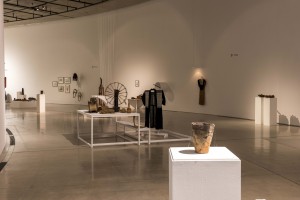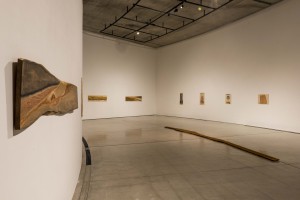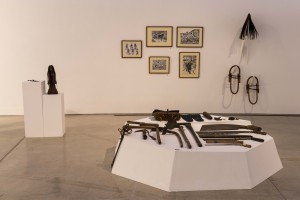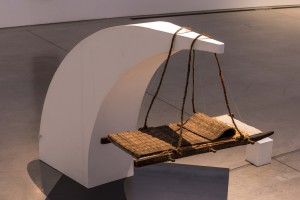
The Aomori City Archives Exhibition with FURUSAKA Haruka ” Lore of the Land”
For the past 14 years, FURUSAKA Haruka has been visiting the villages of the traditionally nomadic Sami people, best known as Scandinavia’s reindeer herders. A frequent visitor of the Sami, Furusaka has learned their way of life in the harsh Arctic environment. In recent years, her experiences with the Sami have inspired her to produce woodcuts that explore life in the mountains and the tools needed to survive there.
Similarly, many of the utensils, clothing, and other materials found in the Aomori City Archives were devised out of necessity and made by hand from hemp, wood, bamboo, and other common materials. Through them, we can catch brief glimpses of the blessings that the land afforded the people of Aomori, as well as the joy, awe, and respect it inspired. We find something akin to the Sami within them—something common to all human beings who live close to nature.
In this exhibition, Furusaka’s Sami-themed woodblock prints are displayed alongside items from the Aomori City Archives, including logging tools and devices, folk materials such as kitchen utensils and clothing, as well as landscape and genre paintings and woodcut prints. Furusaka’s artworks, together with the Aomori City Archives, should provide us with valuable insights into the development of the human-nature relationship.
FURUSAKA Haruka
lives in Osaka, Japan.
BFA in oil painting from Musashino Art University, Tokyo, Japan.
www.harukafurusaka.net | www.kucyusansou.com
FURUSAKA Haruka is independent artist making watercolor woodblock prints, which are based on Japanese traditional printmaking technique. She takes natural soils from ground and use them as different colors of pigments. She tries to translate the traditional printmaking technique to potential and ecological way of contemporary prints.
Since 2003, Furusaka have been to northern Scandinavia where indigenous Sami people live. She researched their handicrafts called Duodji in 2010. She collected words of local people talking about Duodji, and has produced series of woodblock prints. The works has been showed at Gallery Parc in Kyoto 2014, and at Tenoma gallery in Fukuoka 2015.
2002 stayed at the residence Ateljé Stundars maintained by the Council of Swedish Education and Culture in Ostrobothnia, Finland.
2004 was invited and taught workshops in printmaking classes at 5 Colleges and Universities in Philadelphia, Pennsylvania and New Brunswick, New Jersey.
2006 NPO Art Planet plan IGA invited her for artist-in-residence program in Mie, Japan.
2008 to 2010 participated to a project “Book Art Picnic” in Osaka, and worked for the management as a member of the organizer NPO Osaka Arts Aporia.
2012 to 2014 NGO Cordillera Green Network invited her as a workshop facilitator of the environmental education program in Mountain Province, Philippines. Japan Foundation supported the workshops in 2013 and 2014.
—
Exhibition view
photo: NISHIKAWA Koji
[Essay]
Lore of the Land
KANAKO Yukiko
The Aomori City Board of Education maintains a municipal archive of works by Aomori-related artists, artifacts from Jomon-period archaeological sites like the Komakino ruins, as well as folk materials like the utensils and clothing used by the Aomori people from the end of the Edo period (1850s) through the late Showa period (1970s). The archives do not show the authority and trends of so-called rulers of the time. They tell the lives of people deeply connected to the land of Aomori.
In this exhibition, FURUSAKA’s Sami-themed woodblock prints are displayed alongside items from the Aomori City Archives. The ACAC first approached FURUSAKA about exhibiting her woodblock print Duodji from Mt. Reindeer, which is based on the indigenous Sami people of Scandinavia. For the past 14 years, FURUSAKA has been visiting the villages of the Sami people, fascinated by the relationship between their culture and the natural environment. In that time, she noticed that this relationship appeared in both the language and handicraft of the Sami. In a similar vein, FURUSAKA documented the lives and feelings of modern Aomorians for Lore of the Land, listening to stories firsthand through fieldwork and workshops while, at the same time, deciphering how the people of Aomori have lived together with nature over millennia through the archive.
Printed materials introducing each artwork were distributed in the exhibition space of Duodji from Mt. Reindeer. Next to the title of each piece was a short supplementary phrase. At first glance, they seem to detail the scenes depicted in the woodblock prints. But even if you unravel a description such as “In joik we do not sing about an object, but we sing the object itself,” it is not enough to explain the scenes in woodblocks. Rather, it seems like a refusal to explain something essential that needs to be said. That is, beyond a complementary explanation of the prints, the words themselves have been refined to a minimum. Both the words and woodblocks of Duodji from Mt. Reindeer are two representations of a single phenomena hinted at in the work’s succinct title. The woodblock prints and words are equal rather than complementary to each other, and each exists as an independent expression.
As woodblock prints and language form the basis of FURUSAKA’s creative work, this exhibition treated the items within the archive as both representations and manifestations of the lives of the Aomori people. At the same time, FURUSAKA visited people who live with nature in Aomori to listen to their stories. Lore of the Mountain was a consecutive three-day woodblock print workshop held as a part of the exhibition. On the first day, FURUSAKA invited a local plant expert to take us on a hike for edible wild plants in the mountains around the ACAC. After the hike, we listened to our guide’s stories of his experiences in the mountains. A large portion of the first day was given to the research needed before beginning to create a woodblock. The reason for this was twofold: for visitors to experience firsthand FURUSAKA’s techniques and for FURUSAKA herself to conduct research for the exhibition.
FURUSAKA also conducted other additional research, the findings of which are represented as language on pages 2–3 of this catalog.
In woodblock printing, many commonplace Japanese materials are put to use as tools. Wood is transformed into the woodblock, baren (pad for woodblock printing), paper, and ink. The process of woodblock printing is extremely time-consuming. You must carefully carve out the wood; paint the woodblock while, at the same time, prevent it from drying out; and finally you must apply paper to the baren. But one could also say that it is similar to the ways in which the Sami and the people of Aomori have traditionally made their handicraft from materials readily available in their surroundings. FURUSAKA has a deep affection and respect for this kind of handicraft. She even used the dirt she collected on her journeys into the woods as pigments in her process of producing woodblock prints, as if in search of ways to connect with nature.
Together with these woodblock prints, FURUSAKA created her piece River Máze, in which she mixed dirt and water from her home in Japan’s western Kansai region to create a paste, which she then poured into a handmade vessel of Aomori hiba cypress and air dried. The rocks that cover the earth’s surface erode into fine grains of sand, upon which organisms live, die, and accumulate, eventually forming soil. Soil is present wherever plants are born, live, and die, and animals enjoy the benefits. Soil is also present wherever people have lived as we see in the excavation of human civilization through relics and ruins. Soil is a material. It is local and regional, distinguished by certain conditions. It is a layer of life’s accumulation and the strata of earth upon which organisms live and die. In River Máze, FURUSAKA pours the soil of Kansai into an Aomori vessel and gives it a Sami name to synthesize three distinct places. The piece transcends region and country to represent the Earth, which encompasses life in its entirety.
No matter how far science and technology advances, we cannot stop the wind and the snow and the movements of the planet. Wisdom is born out of a need to survive. Out of wisdom, tools and culture are also born in places around the globe. FURUSAKA tries to capture the human figure, powerless yet animate, as she continues to live together with the soil.
- 日時
- April 29 (sat) - June 18 (sun), 2017, 10:00-18:00
- 会場
- Gallry A
- 対象
- admission free
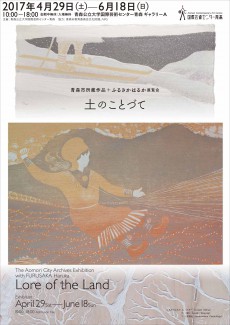
青森市所蔵作品+ふるさかはるか 展覧会「土のことづて」
ふるさかはるかは、14年前から北極圏でトナカイと暮らす遊牧民だったサーミの人々の村を訪れています。厳しい自然の中、トナカイと共に生きる術を身に付けてきたサーミの人々と生活を共にし、近年ではその経験をもとに山の暮らしと道具に着目して木版画作品を制作しています。
一方、青森市が所蔵する道具や衣類などの民俗資料は、麻や木、竹など身近な素材から人々が工夫を凝らして自分達の手で作り使ってきたものです。これらの資料からは、青森の人々がこの土地から多くの恵みを受け取り、喜び、畏れ、敬い、付き合ってきた様子が見え隠れします。そしてそれはサーミの人々や、他のあらゆる暮らしの中でも同様に綿々と続いてきた、自然の中で暮らす全ての人間に共通する姿でもあります。
本展では、ふるさかがサーミをテーマに制作した木版画作品と、青森市が所蔵する山樵道具や運搬道具、台所用品や衣類などの民俗資料や、山や風俗を描いた絵画、版画作品を展示します。ふるさかの作品と青森市所蔵作品を手掛かりに、人間が自然とどう関係を育んできたかが浮かび上がってくるでしょう。
ふるさかはるか
フィンランド、ノルウェーなど極北での滞在制作をはじめ、国内外のアーティスト・イン・レジデンスや大学などで、日本の風土で育まれた水彩木版画技法のワークショップや作品発表を多数行う。1999年武蔵野美術大学油絵学科卒業。2010年より「木版画アトリエ空中山荘」を立ち上げ、2012〜2014年フィリピン山岳地方での環境教育プログラムで、土絵具と木版画によるワークショップや展覧会を開催。2014年には十数年間交流を続けてきた北欧の先住民サーミの人々の手工芸をテーマにした作品を発表。身近にとれる土から絵具をつくるなど、木版画の自然素材を異なる時代や風土に読み替える作品・場づくりを展開している。
www.harukafurusaka.net | www.kucyusansou.com
___________
展示風景
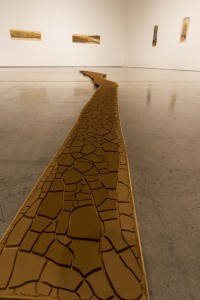
《マーツェ川》
2017年
撮影:西川幸治
【解説】
土のことづて
金子由紀子
青森市教育委員会では、青森ゆかりの美術作家の作品と、小牧野遺跡をはじめとする縄文時代の考古学資料、そして幕末頃から昭和50年頃までの青森の人々の暮らしで使用されてきた衣類や道具などの民俗資料を所蔵している。それらの所蔵品はいわゆる統治者の動向や権威を示すようなものではなく、土地に根付いた民衆がどのような暮らしをしてきたかを物語る。
本展では、青森市所蔵作品とふるさかはるかの木版画作品とを並置し展覧した。ふるさかに出品を依頼したのは、北欧の先住民族「サーミ」の人々を題材とした木版画作品《トナカイ山のドゥオッジ》である。ふるさかは14年前からサーミの村へ通い、生活を共にするうちにサーミの人々が生きる自然環境と文化の関わりに魅かれ、その自然と人間の関係性が、人々が口にする言葉と手工芸双方に現れていることに気付く。これを踏まえ、本展では青森の人々が自然の中でいかに暮らしてきたのかを所蔵品から読み解くと共に、ワークショップやリサーチを通して実際に話を聞くことで、現在の青森の人々の生活や実感を収集していった。
本展の《トナカイ山のドゥオッジ》の展示スペースではふるさかが準備した副読資料が配布された。そこには、各作品のタイトルと、それを補足するような短い言葉が書かれている。それらは一見、木版画に描かれた場面を説明するように見える。しかし例えば「ヨイクでは、対象について歌うのではなく、対象そのものを歌うんだ。」といった言葉を解きほぐしても、木版画に描かれた場面を説明するには充分ではない。むしろ、これ以上何を言う必要があろうかと説明を拒むようでもある。すなわち木版画の補足説明という役割を超え、必要最低限まで精製された言葉そのものが独立する。同作品において木版画と言葉は、タイトルに簡潔に示された一つの事象が別々の媒体で表象されたものである。同作品で木版画と言葉は、補足し合うというよりもどちらも等しく、しかしそれぞれが独立した表現として在る。
木版画と言葉それぞれが現在のふるさかの創作活動の両輪であることを踏まえ、本展では所蔵作品を、青森の人々の暮らしが物質として表象されたものとして扱った。と同時に、ふるさかは現代の青森で自然と関わる仕事をしながら暮らす人々を訪ね、インタビューを行った。本展の関連イベントとして開催した3日連続の木版画ワークショップ「山のことづて新聞」では、1日目に山菜採りのガイドを迎えてACAC周辺の山で山菜を取りながら散策し、その後ガイドの方にこれまでの山での経験を聞く時間を設けた。このワークショップでは、木版画制作のための前段階の、この1日目のリサーチの部分に大きな比重が置かれたが、これは前述したふるさかの制作方法の追体験であるとともに、ふるさか自身のリサーチの一環でもあった。これ以外にもリサーチは行われ、その結果の言葉としての表象が本誌に2-3頁に掲載されたものである。
木版画では、日本で古くから身近な素材である木が版木、ばれん、紙、墨などあらゆる道具に使われる。コツコツ木を彫り、版が乾かないように水加減に注意しながら絵具を塗り、それをばれんで紙に刷り付けるという一連の作業は非常に手間がかかる。しかしそれはサーミや青森の人々が周囲の自然の中で入手した素材を使って手作業で道具を作っていくのと同様であると言え、サーミや青森の手仕事に強い敬意と憧れを抱くふるさかが、木に加えて、自分が出向いた場所で採取した土を絵具として使用する木版画の制作過程によって、自らと自然を結び付ける方法を模索しているようでもある。
木版画と併せて本展でふるさかは、自宅がある関西地方で掘り起こした土と水を混ぜペースト状にした泥を、青森ヒバで制作した器に流し込み、自然乾燥させた作品《マーツェ川》を制作した。地球の表面を覆っている岩石は細かく砕けて砂となり、そこに生物が生息したり死骸が堆積したりすることで土となる。土は植物が生まれ育ち死ぬ場所にあり、動物はそこから恵みを享受する。遺物や遺構などは土の中から発掘されるように、これまでの人間の営みが堆積する場所でもある。土は物質であり、ある条件で区切られた土地や地域であり、営みが堆積した地層であり、生物が暮らす大地である。《マーツェ川》は、関西の土を、青森の器に流し込み、サーミの言葉を与えることで3つの場所が錬金され、それぞれの地域や国を超えた生物の営み全てを内包する土として立ち現れた。
いくら科学技術が発達しても、私達は風を、雪を、地球の動きを、止めることはできない。今いる場所でいかに生き抜くかというところに知恵が生まれ、道具が生まれ、文化が生まれる。ふるさかは、それぞれの土と共に生きようとする、無力だがいきいきとした人間の姿を捉えようとする。
- 日時
- 2017年4月29日(土)-6月18日(日)10:00-18:00 会期中無休
- 会場
- 青森公立大学国際芸術センター青森 ギャラリーA
- 対象
- 無料


